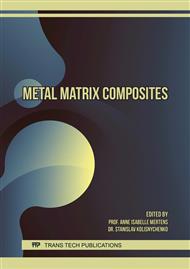p.14
p.23
p.29
p.37
p.42
p.47
p.53
p.58
p.67
Study of Machining Parameter Optimization in Drilling of Magnesium Based Hybrid Composites Reinforced with SiC/CNT
Abstract:
Recently, researchers and engineers have been interested in the development of hybrid metal matrix composites (HMMCs) for the applications of automotive and aerospace industries owing to their superior properties due to the usage a wide range of material combinations in its manufacturing. The present study focuses on the machining of magnesium based hybrid composites reinforced with CNT (1vol.%) and SiC (2vol.%).The influence of machining parameters such as spindle speed, feed rate, drill diameter and point angle on burr formation and surface roughness on drilling the composites were investigated using Taguchi method. The drilling parameters were optimized by using ANOVA experimental design and also find out the percentage of contribution of each factor. Based on the results, the most influential factor for the burr thickness was spindle speed and point angle. While spindle speed and feed rate were the influencing factors for surface roughness. The analysis revealed that burr height, burr thickness, and surface roughness decreases significantly with an increase in spindle speed.
Info:
Periodical:
Pages:
42-46
Citation:
Online since:
June 2020
Authors:
Keywords:
Price:
Сopyright:
© 2020 Trans Tech Publications Ltd. All Rights Reserved
Share:
Citation:



